| Back to Home Text | Back to Williamsville Depot |
| The Williamsville Depot Committee has embarked on an ambitious project to raise in a single event the dollars required to restore the exterior of Lehigh Valley caboose #95050. The 1937 caboose was moved to the depot last June from Hamburg where it had been stored since 1995. Money for the move was raised from The Caboose Affair at the Main-Transit Fire Hall on April 16, 2010. At that time, the trustees of the society determined that exterior restoration required experienced professional labor due to the complexity of the multi-step process and the need to complete it within a two- or three-week time frame. Early estimates place the cost between $15,000 and $20,000. Therefore, with a goal nearly three times the amount raised last year, The Caboose Affair has been merged into Wine, Wheels and Song, a similar, but larger established event. After skipping 2010, Wine, Wheels and Song will return on Friday, May 13 in a new location, the Hearthstone Manor, Depew, after three successful years at the former WNY Event Centre in Clarence. Attendance there ranged from 450 to 850, averaging 600. (Attendance at The Caboose Affair was approximately 175.) At Wine, Wheels and Song IV, 20 New York State wineries will offer sampling and sales by the bottle. Admission also includes a souvenir wine glass (first 500), Hearthstone Manor hot and cold party hors d'oeuvres from 7:00 to 9:00, door prizes, auctions, raffles, live music, and free parking. Admission tickets at $25 pre-sale are available at Hampton Inn and Amherst Bee, Williamsville; Asa Ransom House, Clarence; and Bank of Akron, Lancaster. Also purchase online at www.brownpapertickets.com/event/154811; or by mail to PO Box 416, Buffalo, NY 14231. Inquiries can be made by emailing wnyrailway@gmail.com or by calling 716-633-7002. Chairing the event is long-time society member Don Boyd, who chaired last year's Caboose Affair. He was also co-founder of Wine, Wheels and Song as president of the Clarence Hollow (Merchants) Association (2002-2009), the original sponsor of the event. More than 100 society members and others have been invited by letter to join the committee. Regarding auction donations, call Don at 716-759-7035. |
| In February, new windows were installed in the station agent's office of the Williamsville depot. One hundred and two years ago, the original windows in the same area of this Lehigh Valley Railroad station played an important role in an intriguing drama. According to the September 2, 1909 Amherst Bee, the incident happened several days earlier - just after midnight on August 29. The Lehigh Valley Railroad assigned a special detective, Henry Rook, to keep watch over the Williamsville depot and the railroad bridge just west of the railroad station. (It is interesting to note that the LVRR at times stationed detectives near the railroad bridges in Williamsville, New York during World Wars I and II due to fears of enemy sabotage.) Shortly after midnight on August 29, Detective Henry Rook walked down to the nearby railroad bridge. Upon returning, he noticed that one of the windows in the railroad depot was open. The window in question was probably one of those that led directly into the station agent's office. In 1909, there was a trackside passenger and baggage platform on the south side of the railroad station which would have made entrance into the depot through the agent's window quite easy. Upon seeing the open window, Detective Rook climbed through it. Once in the building, the detective struck a match and immediately saw a man step out from behind a pot belly stove. The man then attempted to attack Detective Rook. The detective jumped out of the depot through same window where he came in. The intruder followed him. Outside of the depot, Detective Rook subdued the intruder with what The Amherst Bee described as "a stinging blow". Then, another man who had been hiding outside of the depot - the prowler's accomplice - also attempted to attack Detective Rook. This action was unsuccessful, and the two men escaped into the darkness. As the intruders ran off (probably down the tracks), Detective Henry Rook took out his revolver and fired a shot in their direction. There was no indication that either of the men was wounded. The Amherst Bee indicated that the interior of the Lehigh Valley's Williamsville depot was later examined and that "it could be seen that the intruders were after booty". The station agent's office was in a state of disorder. The money and ticket drawers had been tampered with and packages that were waiting to be claimed had been opened. The report of this incident in the September 2, 1909 Amherst Bee does not indicate that anything had been stolen from the Williamsville railroad station. As for the intruders, it was thought that they were hoboes. One hundred and two years later, an important restoration project has recently been completed in Williamsville: the installation of all of the windows in the 1896 Lehigh Valley depot. Come to the Lehigh Valley Historic Site on South Long Street in Williamsville and see all of the progress that has been made. And while you're at it, enter the station agent's office. When you do, you'll be walking into the scene of the crime. |
| Finally ! The long-awaited New York State grant has arrived. And already the last five windows have been constricted and installed. The window frames were made of cedar to resist rot, while the glass was produced in the late 19th Century, and is slightly older than the Williamsville Lehigh Valley depot itself. The windows are not of any current standard size. As a result, they are built "from scratch" in the depot. Thanks to the hundreds of hours of labor put in by Mark Klepadlo on evenings and weekends this winter, assisted by Don Wood (who constructed the windows and frames) and Alex Porock, restoration of the Williamsville depot has moved ahead dramatically. At the same time, John Bond has been made considerable progress preparing the interior of the Lehigh Valley caboose for restoration. While the wood stove in the center of the waiting room of the depot provides a surprising amount of heat (at least to the aspect of workers facing the stove), there has been no heat in the caboose. With the newly installed windows, passers-by can examine the interior including the waiting room and the agent's office, and see through the waiting room and through the windows on the opposite wall. The Interior is much brighter, and even at dusk, interior lights are not essential. Meanwhile, Don Boyd and other members of the Williamsville crew are in the late planning stages for "Caboose Affair II", renamed "Wine, Wheels and Song IV" and scheduled for Friday, May 13 at the Hearthstone Manor on Dick Road in Depew, hoping to raise sufficient funds for the professional repair and painting of the Lehigh caboose. With live music, this promises to be a spectacular event, not to be missed. |
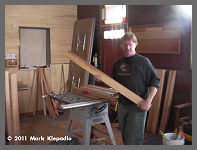 |
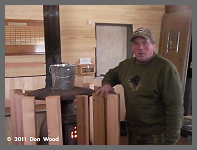 |
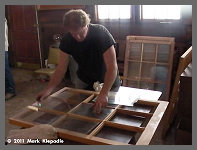 |
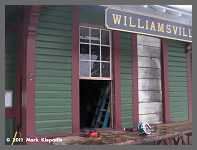 |
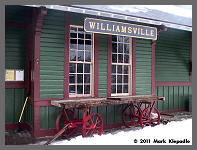 |
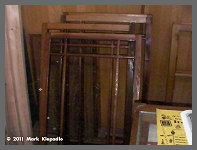 |
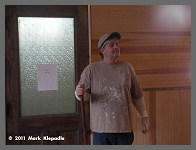 |
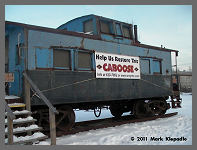 |
 eMail Art T. Thank You!
eMail Art T. Thank You! | On May 18, 2011, the Williamsville Business Association held a "mixer" at the Williamsville depot. On hand at this at this gathering were business owners from the village, members of the Lehigh Valley Historic Site Committee, and Joseph Kocsis, president of the Western New York Railway Historical Society. This event was unique in that it continued to symbolize the close relationship that had always existed between the Williamsville/Amherst business community and the Lehigh Valley Railroad. In 1896, the Niagara Falls branch of the LVRR had an impact on business in Williamsville before the rail line was completed. E.H. Long, seeing that railroad tracks were being built through the village, decided to start a coal and lumber business. A switch and siding were constructed by the Lehigh Valley which allowed deliveries of materials to Mr. Long's company to be made by trains. This no doubt got his business off to a great start. Fogelsonger's Quarry, which existed before the railroad was built, also had a siding built. Transportation of stone to locations beyond local distance was now possible. The Lehigh Valley's business at its passenger station in Williamsville was very modest between 1896 and when passenger service was discontinued there in 1940. Throughout its life, though, the Williamsville depot was always active as a freight station. According to an article in The Amherst Bee dated August 20, 1925, business had increased at the Williamsville railroad station to the point where a modification of the facility had to be made. Between 1923 and 1925, business coming through the Williamsville depot went up 300 percent! The Lehigh Valley responded to this "boom" by adding a switch and a third siding to the team tracks on the north side of its railroad building. The three sidings created a small rail yard that could hold up to 34 railroad cars. Personnel changes happened in the railroad station, too! The LVRR added a full – time assistant and a part – time employee to its Williamsville depot staff in order to help station agent R.C. Harmon with the increased work load. It should be noted that in this same time period, in the mid 1920s, the Lehigh Valley would play an important role in the modernization of the town of Amherst. Roads like Millersport Highway were built with construction materials delivered by the Lehigh Valley Railroad via its Niagara Falls branch. In the station agent's office of the Williamsville depot, there is a framed list of 26 businesses in Williamsville and Amherst that were served by the LVRR. A number of the names are familiar such as The Williamsville Water Mill, Mischler's Florist, Chalmer's Gelatin Factory, and Amherst Builder's Supply. This document is a reminder that there has always been a strong connection between the businesses of Williamsville and the Williamsville depot. By the way, this relationship continues in 2011. The Lehigh Valley Historic Site is a proud member of the Williamsville Business Association. A tradition that began one hundred and fifteen years ago at the Williamsville railroad station is alive today on South Long Street. |
| Work at the restoration of the Williamsville Depot and Lehigh Valley caboose has continued during the summer with several successful work parties organized and spearheaded by Williamsville Project Director, Mark Klepadlo. The Williamsville Depot Crew has grown in size, adding new workers to the crew and new members to the Society. |
| Don also installed the additional security lights on the outside of the depot which have been found to be necessary. The new ticket window with its marble shelf and grating obtained by Mark Klepadlo from Buffalo Re-Use, is quite impressive. |
| A windstorm blew down the telegraph hole at the end of the depot. Jimmie Dawson, who earlier in the summer had helped Don Wood with the construction and installation of the remaining new windows in the depot, arranged for the hole to be dug for a replacement telegraph pole, and Larry Breton then persuaded the Williamsville Village Department of Public Works to bring in and install another unused telegraph pole taken from further down the Lehigh Valley Trail. |
| Comments and Photography by Geno Dailey: I decided to photograph the depot at night. My old Vivitar 2800 flash, which isn't compatible with my camera, proved to be a hugely important tool in these photos, as I had no other way to illuminate the roof of the building. These photos involved a serious amount of layer masking in Photoshop to give a balanced exposure the way your eyes would see the building in real life (also known as making the image look as fake as humanly possible!). To get it illuminated like that, I had to shoot the flash at it 15 times in several places to balance the exposure, along with darkening the lighting inside so it did not look so overpowered. Special thanks to Mark Klepadlo for shutting the light off on the pole near the west end of the building in the view looking east. Thanks to Art Toale for his assistance as well. |
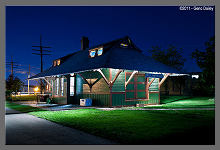 |
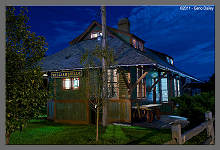 |
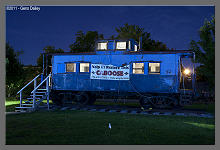 |
| On June 23, 2010, members and friends of the Western New York Railway Historical Society were anxiously waiting at the 1896 Lehigh Valley Williamsville depot for a delivery. They would not be disappointed. Early that hot, sunny June afternoon, a flatbed truck bearing Lehigh Valley caboose number 95050 turned onto South Long Street in Williamsville, New York and slowly made its way to the Lehigh Valley Historic Site. Not long after that, the rail car on the truck was placed on a section of track just east of the Williamsville railroad station. Thus, one journey of caboose 95050 ended and another one began. This is the story of one truly historic piece of rolling stock in the collection of the Western New York Railway Historical Society. The journey of number 95050 begins at the Lehigh Valley's Sayre, Pennsylvania car shops where it was built in 1937. It was the first all steel "northeastern" style caboose to roll off of the LV's assembly line. According to author Dick Steinbrenner in an article in the August 1982 issue of Railroad Model Craftsman, this caboose was constructed at a cost of $4885. The Lehigh Valley chose the "northeastern" style for its caboose fleet. This design was adopted by the LVRR from The Reading Railroad. In 1936, the Reading was the first rail line to build this type of caboose. According to author Mike Schaefer in his book Caboose, the "hallmark of the (northeastern) design were two sets of paired windows on each side and a centered cupola with sloped sides." Including number 95050, the LVRR built 140 northeastern style cabooses between 1937 and 1947. According to an article in an issue of the magazine Railway Age dated September 25, 1937, the LVRR built its northeastern cabooses "to meet the requirements of the state of New York." The article goes on to say that this style of caboose "has been pronounced one of the safest units of its kind by various safety inspectors." The Lehigh Valley first referred to its cabooses as "cabin cars." In 1937, the accommodations inside these rail cars for train crew members were considered to be luxurious. Well known railroad author Lucius Beebe in his 1941 book, Highball: A Pageant of Trains refers to the LV's cabin cars as "the Taj Mahal of cabooses" and "super-de-luxe crummies." Beebe says that the equipment in these cabooses includes "built-in ice water coolers, a refrigerator, sponge rubber bunk cushions, individual lockers for members of the train crew, enamel wash sink, and cream and black paint job." Beebe concludes his caption to a photograph of the interior of an LV caboose by writing, "Only the Happy Valley, where good railroaders go when they die, and the Lehigh Valley could dream up such a luxury hack." Though the travels of a rail car across a vast railroad system would be difficult to keep track of, Lehigh Valley Railroad author, historian, and former employee Mike Bednar has provided a partial accounting of how caboose 95050 was used by its railroad company. In a letter to the author of this caboose history, Bednar indicates that in the early 1950's LVRR caboose 95050 was used on eastbound freights between Coxton and Packerton, Pennsylvania. The caboose was also used on the LV's Bowman's Creek Branch and on extra short turnarounds on the mountain cutoff also in Pennsylvania. In the 1960's, author Bednar believes caboose 95050 may have been used on the west end of the Lehigh Valley Railroad, He reports that in early 1973, "the 050" as he calls it, resurfaced again in eastern Pennsylvania. At this time, caboose 95050 was assigned to the Bethlehem Road Drill (known as "the Birdie") out of the Bethlehem, Pennsylvania engine terminal. Mike Bednar recalls, when the LV took over CNJ (Central of New Jersey Railroad) operations in April of 1972, the birdie was assigned an ex-CNJ caboose, but the LV gave this back to the CNJ in early 1973 when the "050" arrived. The crews all liked the hack (95050) and took good care of it." On April 1, 1976, six northeastern U.S. railroads including the Lehigh Valley were merged into Conrail. Mike Bednar says that in this new era "the 050 stayed on the Birdie for a while but then was sent to Reading, PA for shop work and painting." Bednar lost track of LVRR caboose 95050 (Conrail 18671) after that. Nineteen years later, this Lehigh Valley "hack" resurfaced again according to a story by Jim Szymanski posted on the website of the Western New York Railway Historical Society. Next issue: How Lehigh Valley caboose 95050 joined the Western New York Railway Historical Society! |
| We plan to be just as busy in 2012. The caboose is scheduled to have its exterior properly restored in the spring. To help support this, we are considering the possibility of running a spaghetti dinner in the late winter and a pet show in the spring. The Depot Committee will be sponsoring a Chinese auction at the February Toy and Train Show at the Exhibition Center at the Fairgrounds, and is anticipating our second annual car show in mid-summer, as the first one was so successful. This past fall, Ms. Suzan Mancini donated a locomotive bell to the Williamsville depot. Ms. Mancini is a friend of Society member Paul Ragan, through whose efforts this donation was obtained. Thank you, Paul. Our research shows that this bell came from a Mohawk class New York Central locomotive. This donation is special since it is interactive. Why not come out to Williamsville and give it a ring? The sound is beautiful. Thank you, Suzan. If you would like to get involved with an active project and good fellowship, we value new volunteers. You don't need to swing a paint brush, hammer nails or drive screws. We could use people with computer data and organizational skills. Any level of skills is much needed and always appreciated. |
| In early April of 1995, Jim Szymanski, a trustee of the Western New York Railway Historical Society, stopped at the former Pennsylvania Railroad car shops in Renovo, Pennsylvania, then a private railroad equipment business, to look at former Lehigh Valley cabooses. According to Szymanski, there were 30 former LVRR cabooses stored at the Renovo facility, and all were quite weathered as many had been out of service 10 or more years and stored outside. Szymanski reported about the cabooses he found in Pennsylvania at the April 1995 WNYRHS Board of Trustees meeting. Syzmanski said at the gathering that of the 30 LVRR cabooses he saw in Renovo, three were good candidates to consider for purchase. The price of one caboose would be $4,000. On May 21, 1995, Jim Syzmanski traveled back to Renovo with two other WNYRHS trustees, Joe Kocsis and Don Owen, to further inspect the three cabooses and to choose one to purchase. After looking the cabooses over carefully, the trio of WNYRHS trustees chose to buy LVRR caboose 95050. What the railway society representatives liked about this caboose is that it had never been modernized by Conrail and was still equipped with many of its original interior accessories. LVRR caboose 95050 was then purchased for the Western New York Railway Historical Society by Trustee Don Owen and his wife Barb along with IBM which contributed matching funds. It was picked up in Renovo on September 2, 1995 and arrived in Buffalo the following day. No one expected what happened next. Caboose 95050 was then lost by Conrail. On November 29, 1995 an article appeared in The Amherst Bee newspaper titled "The Case of the Missing Caboose." At this time, almost three months later, the rail car was still missing. The article by reporter Amy Bell indicated that Conrail officials were "keeping a look out for the missing caboose." WNYRHS Trustee Don Owen said at the end of the story in The Bee that he was "optimistic that it will be found, hopefully soon." In early December of 1995, the caboose was found in Campbell Hall, a town in Southeastern New York State north of New York City. Within a few days of being located, LVRR caboose 95050 was back in Buffalo. During its three month tour with Conrail, vandals had covered the sides of the rail car with graffiti. Jim Szymanski, who had first located the caboose, painted over the unwanted "art work" by the lights of his own truck. The once lost Lehigh Valley hack finally arrived in Hamburg, New York, a suburb of Buffalo on December 8, 1995, and was placed on a siding used by the Western New York Railway Historical Society. There it stayed until June 2010. The WNYRHS had always desired to move LVRR caboose 95050 to its 1896 Lehigh Valley depot site situated along a portion of the former LVRR Niagara Falls branch in Williamsville, New York. In the summer of 2009, plans were made to try to move the 95050 to its new home. Members of the Lehigh Valley Historic Site committee (members of the WNYRHS) constructed a section of railroad track on the east side of the Williamsville depot. The track was placed where a siding had been. It should be noted that the rails and ties used were left over from the Lehigh Valley's Niagara Falls branch. In the fall of 2009 and the winter of 2010, plans were made to raise the funds needed to move LVRR caboose 95050 to its new home. On April 16, 2010, "The Caboose Affair," a fundraising event staged by the Lehigh Valley Historic Site committee took place in Amherst, New York. Enough money was raised to move the Lehigh Valley caboose to Williamsville and arrangements were made to get the task completed. On Wednesday June 23, 2010, Lehigh Valley caboose 95050 was moved from Hamburg to the Williamsville railroad site. The rail car was placed on a special truck, and due to height restrictions with regard to bridges and overpasses, traveled a circuitous route from Hamburg east to Clarence, New York, and the back west again to Williamsville. Using two special flat bed trucks, caboose 95050 was carefully placed on that original section of Lehigh Valley track by the Williamsville depot. The entire process from pickup to placement took eight hours! The 95050 sits there today at the Williamsville railroad site on permanent display for all to see. Since then, work has progressed on renovating this Lehigh Valley caboose. WNYRHS members and friends have worked diligently to clean out and restore the interior of the rail car. Efforts have also begun to raise the funds needed to renovate and restore the exterior of the 1937 caboose. On May 13, 2011, "Wine, Wheels, and Song IV," a second caboose fundraiser was staged by the Lehigh Valley Historic Site committee. Plans are now being made to return caboose 95050 to its original 1937 appearance. It's been a long journey since the 95050 came off the assembly line in Sayre, Pennsylvania 74 years ago. The route of this ‘hack' took it through Coxton, Packerton, and Bethlehem in Pennsylvania, and Buffalo, Campbell Hall, and Hamburg in New York. The Western New York Railway Historical Society is proud that caboose number 95050 now rests on Lehigh Valley track in Williamsville. |
| People who visit the Williamsville depot during spring and summer open houses often share memories of the railroad branch line that used to run through the village. A number have reminisced about how noisy switching activity around the Lehigh Valley station could be, especially at night! Some visitors of the Lehigh Valley Historic Site have indicated that they actually went to bed early so that they would be asleep by the time diesel switch engines of the LVRR raised their voices at midnight. Look for more on the Williamsville railroad noise problem in a future South Long Stories column! |
Web Site Hosting by TRAIN WEB
The WNYRHS, Inc., 100 Lee Street, Buffalo, NY. 14210-2110 is an independent organization and has no affiliation with any other local or national group.
The Society is a fully qualified organization under 501 (C) (3) of the Internal Revenue Code and all donations to the Society are tax deductible.
©Copyright 1999 , WNYRHS Inc. all rights reserved